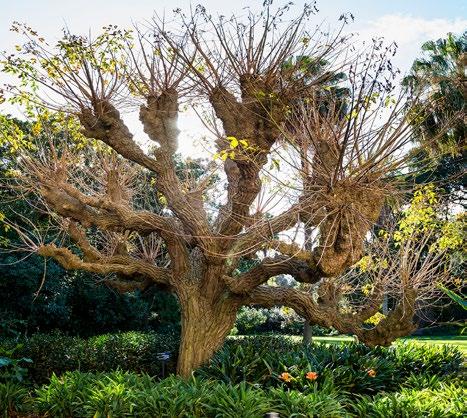
3 minute read
Caring for Melbourne Gardens’ grand old trees
Eleni Vassiliadis, Digital Assistant, Development, Marketing and Communications, Royal Botanic Gardens Victoria
What would the grand old trees of Melbourne Gardens say if they could talk? These historic and, in some cases, remnant trees have witnessed the evolution and growth of Melbourne and require some special TLC as they age. Large old trees are biological treasure troves. The many unique characteristics they develop as they age, including hollows, bark fissures, large volumes of dead wood and complex canopy structures, essentially form micro-ecosystems and enable them to support a myriad of species which rely on them for food and shelter.
Two stand-out specimens are a majestic Araucaria bidwillii (Bunya Bunya Pine) planted in 1897, and the iconic Lions Head Tree, a majestic eucalypt which earned its unique name due to the resemblance of the gall on its trunk to a lion’s head. Considered to be one of the most significant trees growing at Melbourne Gardens, the Lions Head Tree is Eucalyptus camaldulensis (River Red Gum). The species was named for the Camaldoli Gardens in Italy where it was first described in 1832 by Frederick Dehnhardt, Chief Gardener. Dehnardt propagated River Red Gum plants from seeds sent to him in 1818 from New South Wales.
The Lions Head Tree was first photographed in Melbourne Gardens in 1885 and is still going strong in 2019. Calculating its exact age is tricky, but considering it displayed characteristics of an older gum when first photographed, it likely existed in the early 1800s, where it was originally nestled beside a marshy backwater, which the Yarra River would flood into, known as Tromgin to the First People. This tree was most likely a sapling when, in 1835, a squatter camp was set up on the banks of the Yarra River nearby, which would eventually develop into the city of Melbourne.

If trees could talk, the Lions Head Tree would have a remarkable story to tell, bearing witness to life as it was for Indigenous Australians before colonisation and the tumultuous events that coincided with the arrival of Europeans and the rapid and irrevocable changes they brought. River Red Gums are increasingly threatened due to logging, climate change and the general impacts of colonisation. It is critically important to conserve them, as they play an invaluable role in supporting the biodiversity of Australian landscapes, not to mention keeping koalas well fed!
With advancing age, the soil environment of these large old trees steadily increases in ecological richness, benefiting surrounding flora and providing a home for the wide range of microorganisms and insects living within the soil and roots.
At Royal Botanic Gardens Victoria, various strategies are undertaken to enhance the longevity of large old tree specimens that fall within the realm of ‘conservation arboriculture’. These include specific pruning methods employed for old trees which are designed to imitate the slow, natural contraction of the crown that occurs as they reach a great age.
Typically, the tree’s outer canopy is gradually shortened via several small dose pruning events that are implemented over many years – even decades. This method of restoration, sometimes called retrenchment pruning, aims to rejuvenate the tree’s crown and improve health and structure. This is currently being practised by the gardens’ arboriculture team using pole pruners to restore one of the ancient River Red Gums in Melbourne Gardens known as the Cockatoo Tree, following the trauma of losing a large portion of its crown during high winds in 2013. The arboriculture team is working on this tree’s structure and health so that the Cockatoo Tree can continue to sustain and enrich biodiversity for years to come.
Another technique practised by the arboriculture team is pollarding, which is used to control tree size and form and has an additional benefit of enhancing tree longevity. Pollarding is practised on trees of every age, but must commence while the tree is young, and involves the periodic (often annual) removal of the upper branches of a tree. The technique dates back as far as Neolithic times and was used historically to produce firewood, feed for livestock, and more, with the advantage of not killing the tree. The practice produces a striking knuckled appearance, which is visible on an Erythrina crista-galli (Cockspur Coral Tree) specimen growing in Melbourne Gardens, which is pollarded using chainsaws.
This careful work ensures these special inhabitants of the gardens will live through the further evolution of Melbourne and continue to play their part in supporting the life of the gardens for many years.

The Cockatoo Tree, an old River Red Gum (Eucalyptus camaldulensis), which is currently being restored.










